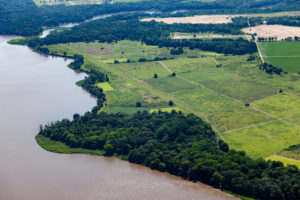Design and Plant Your Buffer
100 feet of streamside forest will adequately protect the physical, chemical, and biological characteristics of most streams. However, narrower buffers are also beneficial for improving water quality.

Many landowners are happy growing a forest next to their stream for clean water and habitat. But with extra planning, landowners could harvest products from their forest buffer. These multi-functional buffers may not be eligible for some of the federal programs that have been outlined under the Funding section, but they may appeal to landowners for other reasons.
Ideally, the buffer along a stream whether urban or rural, should be contiguous. Achieving such uniformity can be even more challenging in developed areas, and there is the additional challenge of potentially heavy use by people. A typical stream in a developed area goes through a city or residential area where there may be only narrow bands of land available for planting. Any buffer width is beneficial, but buffers that are at least 35 feet wide provide better water quality improvement. Visit the Chesapeake Tree Canopy Network for tools, best practices, and resources for establishing, maintaining, and protecting riparian forest buffers in developed areas.
Resources
• Conservation Buffers: Design Guidelines for Buffers, Corridors and Greenways
• Chesapeake Bay Riparian Handbook: A Guide for Establishing and Maintaining Riparian Forest Buffers
• Maryland DNR: the 3-Zone Buffer System
• Maryland DNR Riparian Forest Buffer Design and Maintenance Handbook
• Pennsylvania DEP Buffer Planning and Restoration
• Streamside forest buffer width needed to protect stream water quality, habitat, and organisms: a literature review
• Why add edible and floral plants to riparian forest buffers?


